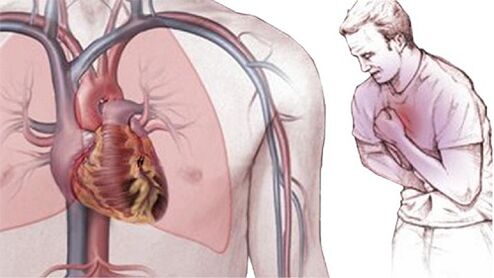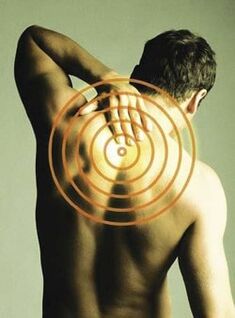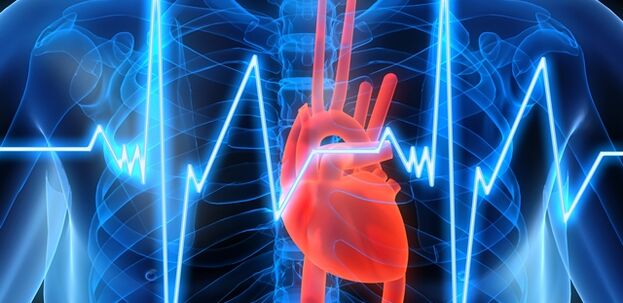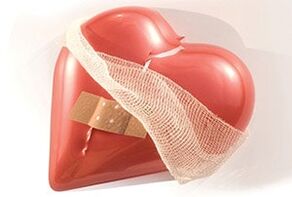
It happens that a person goes to the doctor with a complaint about the heart. Specialists sent it for examination, but it did not reveal any pathology. It is good when a cardiologist recommends consulting a neurologist. In this case, he may report that not heart disease is to blame, but osteochondrosis.
It turns out that one of the symptoms of thoracic osteochondrosis is pain in the mammary gland or heart. It can be exciting, painful and stressful. In some cases, there is a feeling of warmth in the thoracic region and rhythm disturbances. Over time, the pain may become worse and worse. In this case, drugs for the heart do not help.
Features of heart pain in osteochondrosis
Many people have a question: can the heart hurt with osteochondrosis? yes. Patients often complain about the following:
- Persistent heart palpitations and chest pain.
- Gradually, there is pain in the heart with osteochondrosis.
- Painful sensations are dull and pressing.
- The intensity of the pain in the sternum is low.
- Reception of nitrates does not relieve pain in the chest.
- Patients try to make fewer movements with their upper limbs, as a result of which the sensation of pain increases.
Sometimes cervical and thoracic osteochondrosis appear simultaneously, in this case, additional pain occurs in the neck. Patients may complain of the following:
- Shoulder, face and neck pain.
- Discomfort extends to almost the entire upper chest area, affecting the muscle tissue of the spine.
- Attacks can last several hours or even several days.
Sometimes the cause of reflected pain lies in the squeezing of the vertebral artery. In this case, the following symptoms appear:
- dizziness;
- hearing and vision impairment;
- pressing pain in the back of the head;
- antihypertensive drugs do not give the desired effect;
- feeling weak;
- difficulty breathing;
- loss of consciousness;
- blood running down the face.
Symptoms of osteochondrosis of the spine, and how heart pain in women and men are no different.
What is the effect of osteochondrosis on the heart? The disease is accompanied by changes in the spine, especially in the area of the spinous process of the lower cervical vertebrae. Weakness of the little finger and decreased muscle strength of the left hand may be felt.
How to distinguish heart pain from osteochondrosis

How to recognize: is the pain caused by heart pathology or osteochondrosis? Solving the problem is not easy: in each of the two cases, the cells can emit severe pain and pain, and during physical exercise, the discomfort increases.
Although it is quite difficult to distinguish angina pectoris from thoracic osteochondrosis, there are signs that will help determine the true cause of the pain.
Differences in heart pain in osteochondrosis:
- Long duration of pain: they last for weeks and months.
- Seizures occur with sudden lifting of the arms and head, tilting and twisting, and coughing.
- Pain can disappear and decrease and subside when the body is in a comfortable position.
- With various ECG violations not detected.
- When the chin is tilted to the chest, the pain increases, this is a sign of intervertebral hernia.
- With pain, there are no attacks of anxiety and fear.
- Staying in one position for a long time (for example, while sleeping) can cause pain in the heart.
- Glycerol trinitrate does not help relieve pain, for this you only need to use analgesics.
- Heart pain in osteochondrosis with a sudden change in body position immediately increases, it occurs when sneezing, coughing, taking a long breath and sudden head movement.
- When exposed to the spine, the intensity of the pain increases.
- Heart pain in the thoracic region with osteochondrosis is not life-threatening.
Now let's see how to determine what hurts the heart with angina. In this case, there will be pain like:
- short duration;
- not related to physical activity;
- heart medications help stop or reduce pain;
- the sensation of pain does not change if the load on the spine is constant;
- pain has the same intensity;
- pain sensation spreading to the arm, jaw and under the shoulder blade on the left side;
- pain can be caused by neuropsychic overstrain;
- cardiogram reflects the presence of pathology;
- the patient has a fear of death;
- can cause the death of the patient.
Nature of pain in osteochondrosis

Many are interested in how the heart hurts with osteochondrosis. Discomfort is felt not only in the chest, but also in the upper abdomen, in the ribs and near the spine. Movement is restricted by staying in the same position for a long time, while the pain increases. A short walk helps relieve discomfort.
In addition, there may be pain in the back and in the shoulder blade area. It can get worse when you take a deep breath. The level of discomfort is affected by temperature (decrease) and changes in atmospheric pressure.
Osteochondrosis and pain in the heart are aggravated by turning the body. This is due to increased load on the anterior vertebral disc. Often there is a syndrome in this area. When inhaling, pain may occur in the intercostal space. Back muscle tension is possible, accompanied by unilateral spasms.
Sometimes the heart hurts with osteochondrosis so it seems that there is a problem with the organs of the chest cavity. The disease can be disguised as intestinal and abdominal pain, and in some cases may resemble appendicitis. If no action is taken, osteochondrosis will not only radiate to the heart, but pathology of the respiratory, cardiovascular and digestive systems will also occur.
The nature of the pain may change. Exacerbations can be replaced by remissions, they occur in waves.
The cause of pain in the heart with osteochondrosis

Distinguishing a heart attack from osteochondrosis is not always easy. In the human body, there is a complex transmission of impulses from various systems and organs to the brain and vice versa. This allows him to collect information about all systems and manage their work. As a result, a connection is formed between the nerve endings and the spinal cord, which is located in the spine. When they are violated, the transmission of impulses occurs with violations, the brain reacts incorrectly, pain appears that radiates to the chest and heart area.
Pain in the heart with osteochondrosis appears in the following order:
- Changes occur in the spine due to injury.
- The intervertebral disc protrudes, this does not affect the fibrous ring, which is prone to protrusion.
- If there is a rupture of the fibrous ring, the center of the cartilaginous disc enters the brain canal, resulting in a hernia.
- osteophytes are formed.
- The vessels and nerves surrounding the disc begin to flatten.
- The emergence of pain syndrome.
With osteochondrosis, the heartbeat may become more frequent and tachycardia may appear. Injuries to the spine in different areas can give different pain symptoms. Neuralgia is influenced by the level of damage:
- only the vertebral bodies;
- intervertebral disc;
- ligamentous apparatus;
- paravertebral muscles.
How does osteochondrosis affect heart function? After deformation, the disc compresses the spinal nerves. This leads to pain. Osteochondrosis can affect not only the heart, but also cause pathology of the entire spine. The disease can spread to adjacent departments, which leads to the appearance of new symptoms.
Symptoms of pain in the heart with osteochondrosis
Signs and symptoms of osteochondrosis with pain in the heart often occur against the background of a completely healthy heart system. Often they are stable, but can appear and increase paroxysmal. In the case of problems with the spine, dull, deep and pressing pains, their characteristic is not sharp severity. With pain in the chest area with osteochondrosis, glycerol trinitrate does not help, because the cause is not in the heart.
To distinguish pain in the heart from thoracic osteochondrosis, it is important to know that different sensations may occur. For example, they can spread from the affected area to the muscles of the anterior part of the chest, to which the cervical roots from the fifth to the seventh are connected. In this case, pain can be felt in the upper left part of the body, sometimes also affecting the face. At the same time, vascular disorders are not diagnosed, ECG does not detect abnormalities. This happens even at the peak of pain.
How does thoracic osteochondrosis affect the human heart and body?

One of the manifestations of osteochondrosis is squeezing or pinching blood vessels. This leads to the narrowing of the "channels" through which the blood passes. In order for the organs to continue to receive it in the right amount, the heart needs to work more actively. This means that the number of contractions increases every minute. As a result, blood pressure increases. This is the effect of osteochondrosis on the heart.
Violations in the work of the circulatory system lead to the appearance of pain in the heart with osteochondrosis of the chest and oxygen starvation of the brain. As a result, the above symptoms occur. Reactions, speed of thought, emotional state, orientation in space and memory depend on the work of the heart, as well as problems with vision or hearing.
Because of all these consequences, it becomes difficult to determine whether the heart is sick or thoracic osteochondrosis.
Diagnostics
How to determine that the heart hurts from osteochondrosis? There are special procedures that will help determine the form and extent of the disease. When the disease worsens, it is better to see a doctor. The doctor may advise you to undergo a differential diagnosis, which will allow you to determine the cause of the disease - heart or spine. It may include the following procedures:
- Electrocardiogram. When recording an ECG, it is possible to immediately identify heart pathology. If the results are normal, then it will be clear that the cause of the pain is neuralgia or osteochondrosis.
ECG is a mandatory diagnostic procedure for the formation of chest pain.
- ultrasound. It is carried out for patients with suspected heart infectious lesions. It is used as an additional method.
- Radiography. X-rays are prescribed for patients with suspected osteochondrosis. The picture will allow to determine the destructive destruction of the joint. With heart problems, they will not suffer.
- CT and MRI. They can help if x-rays are inconclusive. This method will determine the lesion more accurately. Magnetic resonance imaging will help diagnose osteochondrosis and heart pathology.
Treatment
Rest and bed rest will help relieve pain in osteochondrosis. The surface should not be too soft or hard. The pillow is chosen in such a way that the neck does not bend. You can relieve the pain if you place a non-hot heating pad under it.
Treatment of thoracic osteochondrosis is carried out in the following ways:
- Medicines:
- vasodilators;
- neurotropic drugs;
- diuretic drugs;
- analgesics;
- non-steroidal anti-inflammatory drugs;
- chondroprotector;
- tranquilizer.
- Physiotherapy. The patient undergoes a procedure in which the affected area is affected by an electric field and current with a variable frequency. This will help start the natural tissue regeneration mechanism.
- Use of turpentine, ointment containing snake or bee venom, as well as pain relievers. They activate the release of heat in the muscles, improve the condition of nerve roots, dilate blood vessels.
- Acupuncture. With the help of needles, energy meridians and active points are affected.
- Manual therapy. Thanks to them, the degenerative process in the spinal column is corrected and an impression is made on the intervertebral joints.
- A back massage will not allow you to get the desired effect. The muscle is located around the vertebral disc, it is almost impossible to reach it. The effect provides a very deep and acupressure massage. Before this procedure, it is recommended to take painkillers.
- At home, you can use warm heating pads and warm compresses to reduce muscle tone.
Manual therapy and acupressure should be performed only by a qualified orthopedist, neuropathologist or traumatologist who has undergone special training and received the appropriate certificate.
Taking heart medication is usually the first and most powerful treatment for the disease. When used with other methods, the results can be significantly improved. Armed with knowledge, it's time to start treatment!
self-treatment errors
Often, patients with complaints of thoracic spine disease make a serious mistake during self-treatment - they take drugs if there are contraindications to them. For example, the older generation prefers to use NSAIDs from the group of phenylacetic acid derivatives. However, it should not be used for problems with the gastric mucosa. It is typical for people over the age of 50.
Therefore, we look at the differences and what is the difference between the symptoms of angina pectoris and osteochondrosis, and also get acquainted with the methods of diagnosis and treatment. Work with a qualified doctor and follow their guidance. Be persistent and consistent, and you will be able to overcome this painful and dangerous disease! Remember, it can be very dangerous. So much so that patients can be released from military service.
































